What is French nymphing?
(including video below)
The group of tactics now known as French nymphing was a hugely significant development in the world of river fly fishing. Today the approach has morphed into many variations on a theme – and some of those variant tactics are very different from the original design. You will probably have heard of tactics such as “tight-line nymphing”, “tactical nymphing”, “Spanish nymphing” and “Euro nymphing”.
These can either be variants of the French nymphing techniques or more general terms for a collection of short and long-line nymphing approaches.
This article will help you get a clear idea of the famous French school of nymph fishing WITH:
Quick-start Video Demo
Photographs of Genuine, Historic Flies from World Championship Competitors
Basic French Nymphing Rig (with Diagram)
Strike Detection with AND WITHOUT leader indicator
Introduction to Legendary Triple World Champion Pascal Cognard (France)
How to get top level nymphing tuition for FREE
Typical French Nymphing
It is important to recognise that there always were (and still are) basically as many variations of these tactics WITHIN the French national fishing team as there are BETWEEN different nations. For example, I don’t think that the physical tactics of “Spanish nymphing” have any fundamental differences to what the French (and Belgian) anglers were doing when this phrase was coined...
Instead, the "Spanish" label is perhaps most useful as a shorthand for much thinner (often level) long nymphing leaders...However, that only really makes sense when you're already familiar with the mechanics of what has - for better or worse - been labelled "French Nymphing".
Here’s a Video Demonstration of the typical mechanics in action:
You can see, above, the basic idea of delivering the nymph or nymphs upstream or up and across stream before tracking them downstream at the pace of the current until the point just before slack line develops. Then you pick of and re-cast. Although simple, there are a lot of little details involved that make big differences to your success.
Did you see the big fish "flash" at my fly? This was something I did not have a good angle to see from my position. I had lost sight of my hotspot nymph because of glare on the water surface. Look out later in the article for a full explanation of this topic...
Although the "gold standard" in this presentation is always to hold as much leader off the water as possible (including the indicator line-section), there are sometimes occasions where you need to anchor at least some of it on the water. My strong advice, though, is you should always have a really good reason to allow the indicator to touch the water. In the video below, the water I'm reaching across is so shallow and spooky that I shouldn't stand any closer to the drop-off I'm targeting. If I raised my rod tip any higher during the drift, the nymph would be dragged round in an arc and pulled away from the "hot zone":
You might also like to keep an eye out for the extra tips and tactics revealed in my free Nymphing email tutorials.
But first, a problem...
The problem with labels
Attempting to classify any fishing technique is almost impossible because humans always want to tell a nice neat story. The problem is, fishing evolves in a messy, complicated way with many overlapping strands. The best we can do is pull some of the different strands together to make a decent “near as damnit” description:
In its most general sense, French nymphing is using a long fly rod with a low AFTM-rating (e.g. 10ft/3m rated for AFTM #3 lines and lighter) to cast one, two or three nymphs on a long nylon monofilament leader – without using a fly-line.
That leader provides the casting mass and the turnover. The key feature is the ability to hold this leader off the water by holding the rod at a high angle – while being able to cast flies just using the rod and the leader. You can even cast a dry fly using a French leader – and that is a tactic we’ll also cover.
How About Rods for French Nymphing?
These are best covered in my guide to the best overall European Nymphing Style rods on this link:
Guide to the Best Euro Nymphing Rods
What are the Key Elements to Look for in French Nymphing?
When fishing with a French leader setup, your rod and line form an inverted “V” shape – with the water between the angler and the fish being undisturbed by the splash-down of a fly line landing on the surface. This is critical and it looks like this:
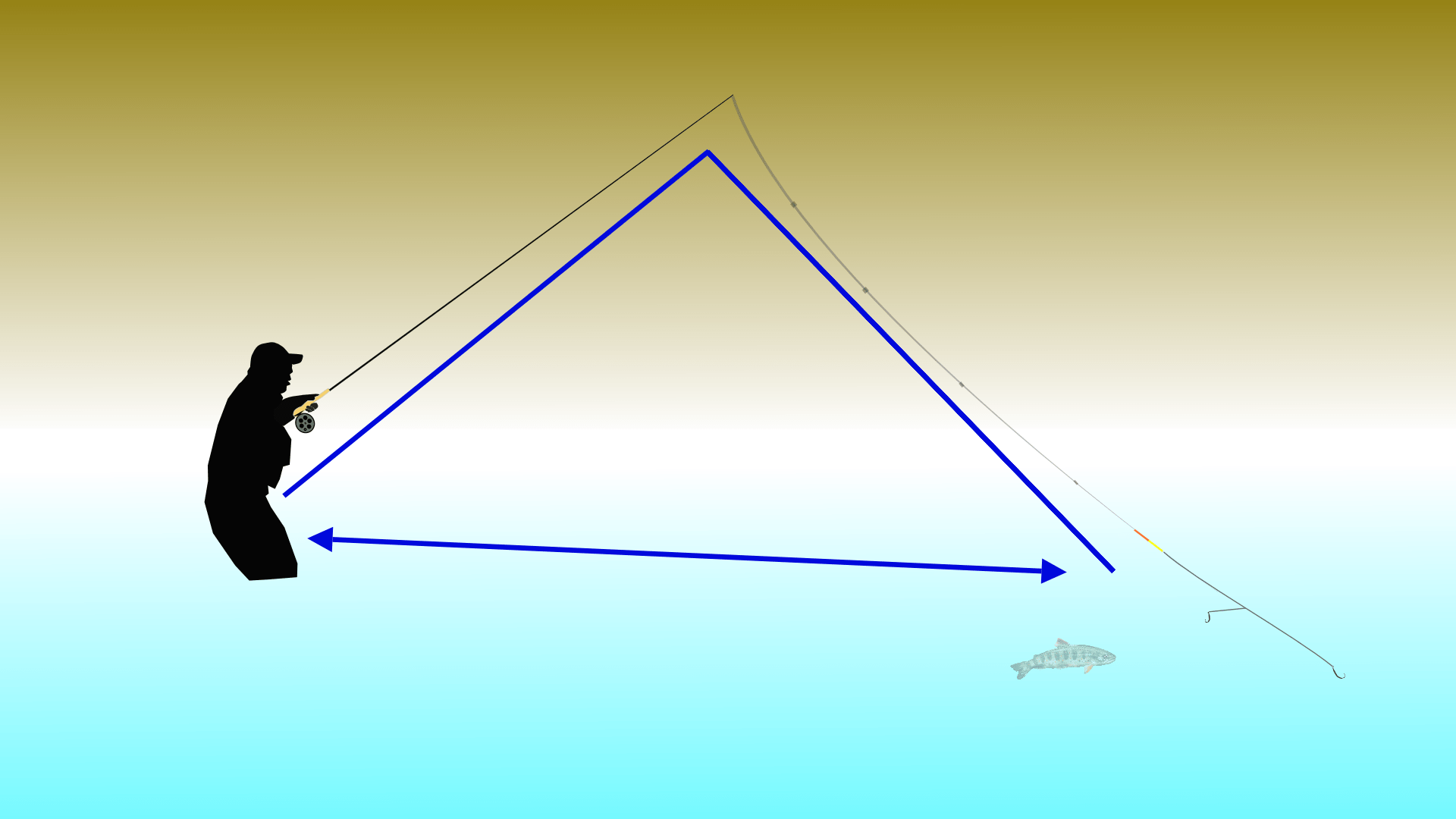
The high rod-tip position and perfect tracking of the drift keeps everything off the water
Something that you will hear myself and John talking about a lot is “The Triangle of Awesome” – which is a short version of our joke phrase “Triangle of Awesome Fly Fishing Advantage”. Both are tongue-in-cheek ways to describe something that actually provides SERIOUS advantages.
It is the delivery of your fly (or up to three flies) to the fish WITHOUT any line-splash – combined with excellent drift control at a distance away from the angler – that makes this technique so deadly. Remember that it is impossible to catch a fish on a fly when it has just been spooked (nobody in history has managed it yet - unless they foul-hooked a fish as it bolted!).
Nowadays you will see lots of anglers using really heavy nymphs on a French leader (because of the “contact” and drift control at range – as well as sensitivity to when a fish grabs the fly). Using heavy flies in deeper/powerful flows is a big diversion from the reasons the original techniques were invented (or RE-invented when compared to historic fixed-line fly fishing).
The original challenge that inspired French Nymphing as a solution was a combination of ultra spooky fish in shallow, clear water. Here’s one account from an angler involved in solving that problem – starting with a very special fly design…
Philippe Beranger and his “Grain of Rice” French Nymphs
I remember talking to Stuart Crofts (international river competition angler) at an evening meeting of our fishing club. Stuart is incredibly passionate about fishing, fish and rivers – and that night he was bubbling with enthusiasm to show me something he knew I’d be fascinated by. He was dead right too…
After opening his fly box, a small handful of beautiful little nymphs was revealed. Very simple in design, they were unlike anything I’d really seen before. This is what Stuart had to say when I asked him about their backstory recently:

Stuart Crofts
15 England Caps
Now, the nymphs. Yes these were a revelation to me. Small (size 20 and smaller) were given to me in 1998 during the World Fly Fishing Championships in Poland (for the record England won the bronze medal).
The name worthy of note was Philippe Beranger from the French Team…
Talking with Stuart that night he said that Philippe had some really helpful guidelines for getting those flies just right. The basic tying recipe is really simple. Tails are simply the hackle-barbs clipped from a suitably-coloured feather. The underbody is made from ultra-fine copper wire (many anglers now like to use stripped peacock quill). The head is a few turns of orange floss and then the entire body and head are varnished.
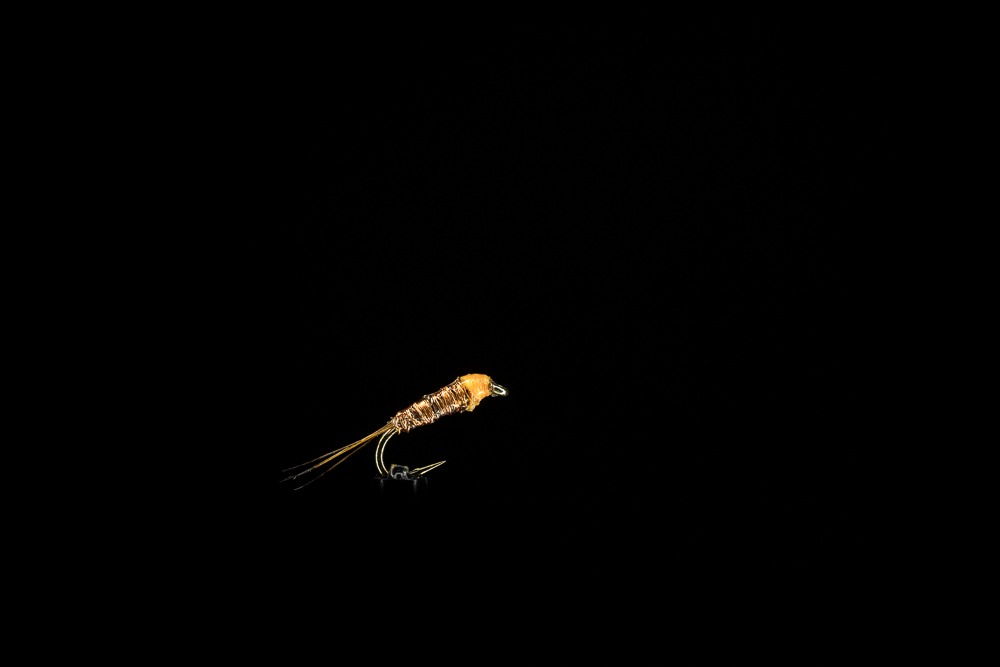
A nymph out of Philippe Beranger's own fly box - size 22 hook. The body is fine copper wire, the head is floss & varnish covers the entire body: Form Follows Function
The secret, Philippe said, was to try to make the body of the nymph look like a tiny grain of rice. The photo shows one tied by Philippe and gave to Stuart Crofts as a gift in 1998.
Their small size and slim dressing means that these flies are a million miles away from a heavy “bomb” type of nymph.
They are small, skinny and sparse – but also very smooth and streamlined. That lets them land quite gently on the water – but still easily cut down through the surface.
It would not be unusual to just fish these nymphs as a single fly – and with this in your mind’s eye it is easy to see what a refined and perfect solution to those ultra-spooky fish this system would be. Stealth and finesse were the core qualities needed and that is exactly what the French nymphing and French Leader system delivered.
However, it's important to see how difficult it would be to untangle "pure" French nymphing from other styles being developed in Europe. The combined effects of cross-pollination of ideas and just the simple process of talented anglers meeting similar problems with similar solutions leads to "clear-water" flies like the Italian team Captain Edoardo Ferrero's "Cochito" nymph below:
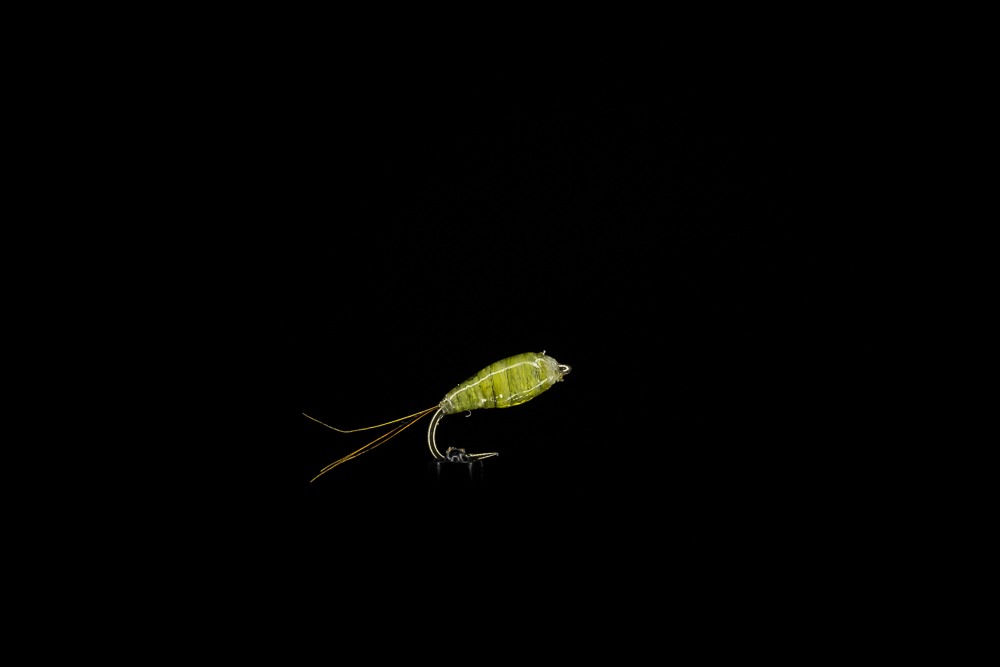
Edoardo Ferrero's "Cochito nymph" has hackle-fibre tails, lead underbody, olive tying thread body a fine mono rib and, again, the whole thing is coated in varnish. This he called a "clear-water" nymph and would be fished in large rivers as well as small ones. Again, form follows function!
Again, huge thanks go to Stuart Crofts for sharing his collection of souvenir flies from multiple World Championships. The Cochito came direct from Edoardo's fly box in the same 1998 competition that Philippe Beranger also attended.
The French Leader
To expand on that system – let’s look in more detail at the vital leader characteristics at the heart of French nymphing…
An ultralight casting “line” (in this case the leader) would be made by knotting together particular lengths and diameters of nylon to create a certain kind of turnover. Those turnover qualities range between “super slow with an ultra-soft landing” to something quicker and more “aggressive” – to fish at longer ranges with light flies or perhaps combat windy conditions.
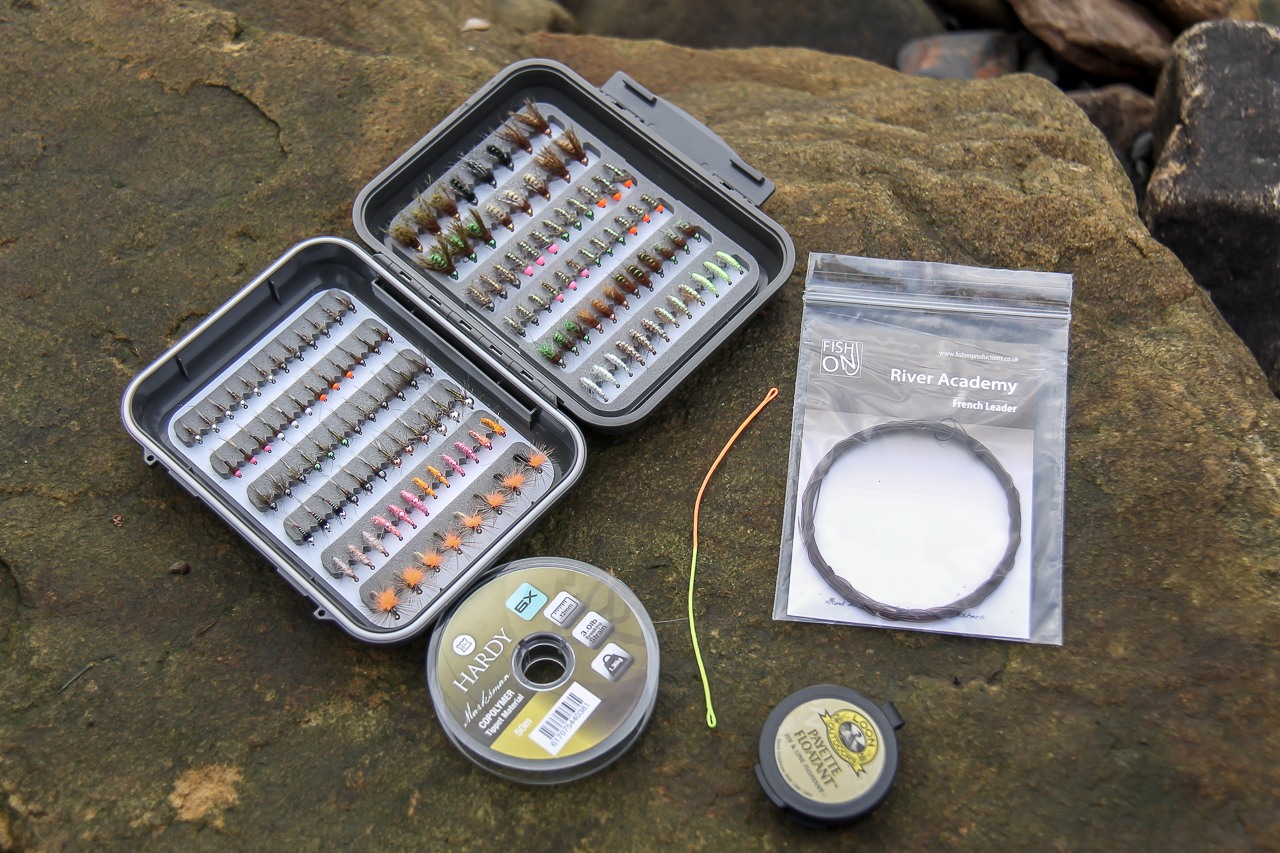
High quality French Leader (right of frame) along with hi-viz braid indicator, tippet and a selection of flies that can all be presented on that leader
Each individual angler would design and test their own preferred leader “recipes” for different conditions and tactics. Their attention to detail was phenomenal.
Also, before attaching to the end of a fly line, the whole leader would be chemically-treated to make it softer and more supple. That process would tend to shorten and slightly thicken the filaments as well as the change in texture. To me, this long and painstaking experimental development is a wonderful cocktail of science and art – perhaps a bit like the fine cooking tradition that France is famous for.
I’m fortunate that John Pearson is the other half of Fishing Discoveries. Why? Well, John is recognised (among those in the know) as making some of the very best hand-knotted French leaders anywhere in the world. In our upcoming premium content, we’ll actually share John’s secrets for making your own French leaders up to his standards.
Now let’s break down the Rig…
Basic French nymphing rig outline
Here’s a diagram of the long, light-actioned fly rod, leader, indicator and tippet. Following this basic outline will set you up for success as you start using these tactics:

The "braid" indicator in the diagram above could just as easily be brightly coloured monofilament "indicator tippet"...
Again, the knots we prefer (because of their ability to retain the breaking strain of fine tippets) and other small details of this rig are covered in my free email lessons. The important thing to remember is that each part of the rig is designed to create some separation between the angler and the fish – while allowing the casting line (leader) to be held off the water. Those are the most important advantages of French nymphing tactics.
With experience, it is possible to modify this basic rig to suit a range of specific conditions and tactics – so the equipment and setup are always supporting the angler’s technique. That is always the gold standard in any angling approach.
Detecting When a Fish Grabs your Nymph
Keeping a light tension in the leader between your rod tip and your “point” fly (the one on the end of your tippet) with your high rod- tip held high and tracking the drift at the pace of the current is a vital skill. It is that pace of tracking and keeping light tension that creates a natural drift. It also maintains the “contact” between rod tip and fly necessary for a sensitive indication of when a fish eats your nymph.
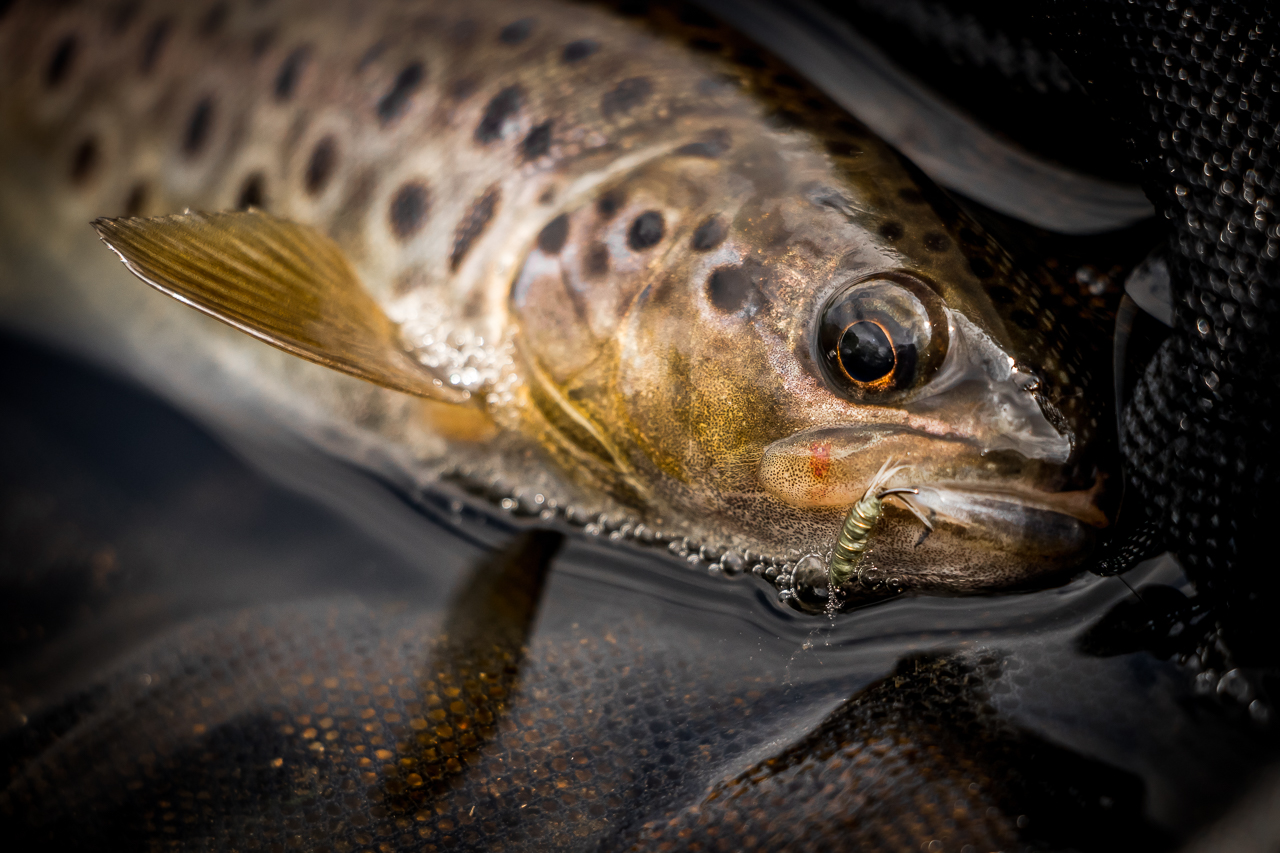
The Rice Grain style strikes again (one I tied that is part way between a Cochito and one of Philippe's varnished nymphs).
The rig diagram shows a short section of bright "indicator" line, attached at the junction between the tip of the French leader and the butt of your level tippet section. For the best results, treat this section of line as if it is a section of leader - and not a separate "indicator". It is just a way of making your line more visible.
Using this setup, the moment when a fish grabs hold is shown by a pause or twitch (or some other change to the natural downstream movement) of the bright indicator braid.
That is your cue to set the hook.

Italian river rainbow for coaching client Susan on a nymph (photo: Susan Skrupa)
French nymphing without an indicator?
In its original format, a lot of French nymphing strike indication often involved some aspect of “sight fishing”. In fact, the bright indicator line may not be included at all. The video at the start of this article shows me fishing a version of this style. This, then, was one of the reasons for some of the developments in nymph characteristics.
Including the dual purpose “hot spot”…
French Nymph Patterns Evolution: A Biased Account
I freely admit that this is a biased account. Actually, it is deliberately biased so that I can pull out features that will help you most in your fishing. With that said, it does also include insights that I believe have not been published online anywhere before (at least in English).
Early Ancestors
Philippe Beranger revealing the secrets of his tiny nymph design is a great example of a unique insight – and please DON’T underestimate that pattern. Like most brilliant fish-catching flies, they might not look extra special in the box; but their simple design and perfect profile work wonders.
Of course, Philippe was just one of a large and talented group of French anglers who was using similar patterns. It is just one style of dressing that were a good fit for the ultra-spooky fish in highly pressured European rivers.
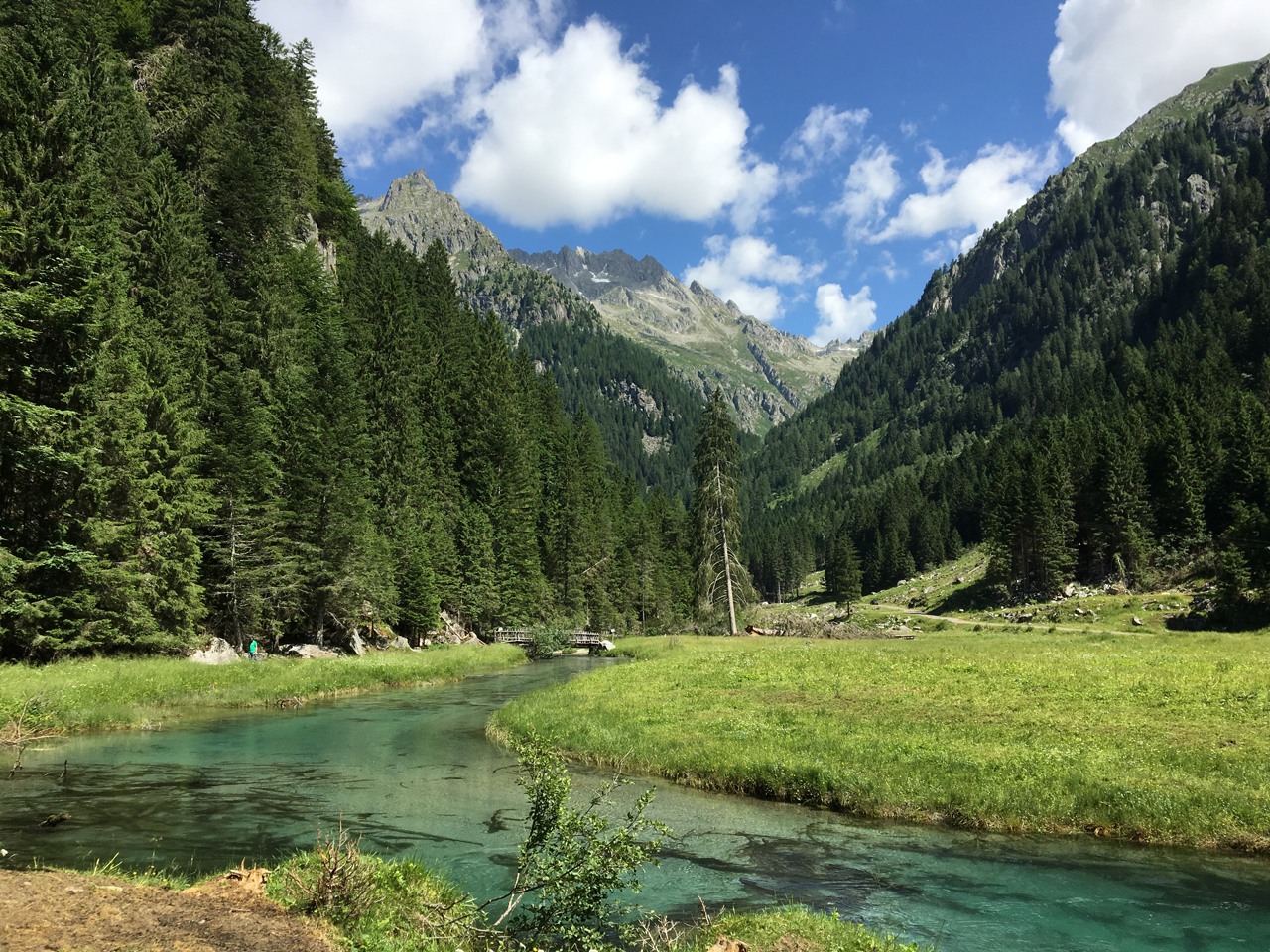
Crystal Clear Italian River (photo: Susan Skrupa)
As a delicate “non-spooky” nymph pattern they are still an excellent addition to your box.
They are particularly good for pitching at spooky fish in relatively shallow water (as the only fly on your tippet).
Hi Viz for Who?
The use of “hot spots” in flies is not new – the bright tags on centuries-old wet flies tell us that much. They often seem to make artificial flies stand out and be extra-attractive to fish.
It can be a mistake to only stop at the obvious conclusion though. Yes, super-conspicuous spots on flies are visible to fish – but they can also be more visible to anglers as well.
Earlier in this article (and in the video demonstration), the “sight-fishing” roots of French nymphing are mentioned. To help the angler when detecting strikes by watching the fly, bright orange or white heads have been used so that the fly is easier to visually track underwater.
Originally, these were often created by wraps of bright floss at the head of the fly (with a similar overall profile to the naturalistic patterns like Edoardo's Italian "Cochito").
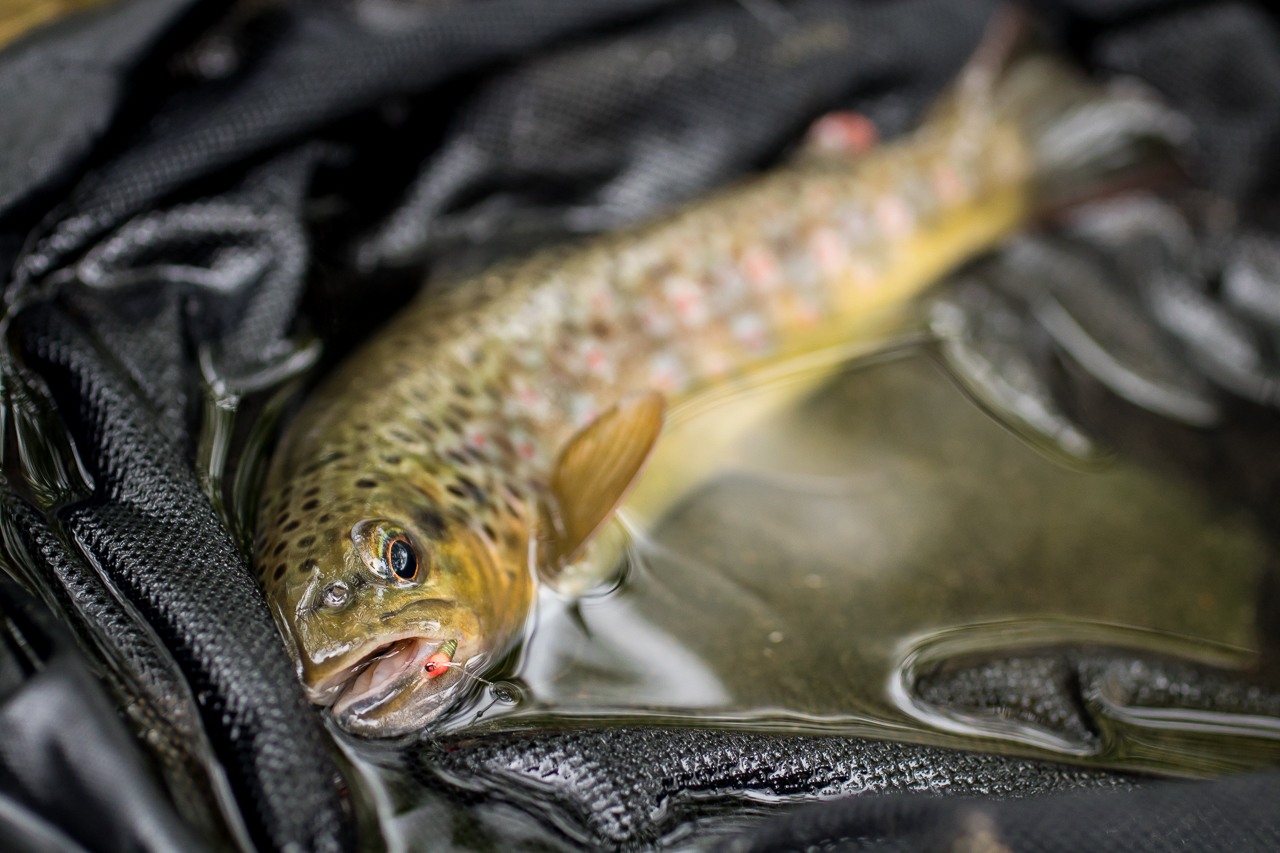
Again, this is still an effective way to create the double benefit of some extra fish-attraction and visibility to the angler. Understanding the reasons behind those developments also puts you ahead of the curve when it comes to more recent developments…
French Nymphing Patterns Everybody Knows
The “Frenchie” style of nymph that is widely recognised today has a neat tungsten bead head, a slim (ribbed) body of thread or feather-fibre/quill and tails projecting from the tip of the abdomen. There may be a contrasting/conspicuous collar of dubbing or floss and the tungsten bead might also be almost any colour – from subtle to hi-viz.
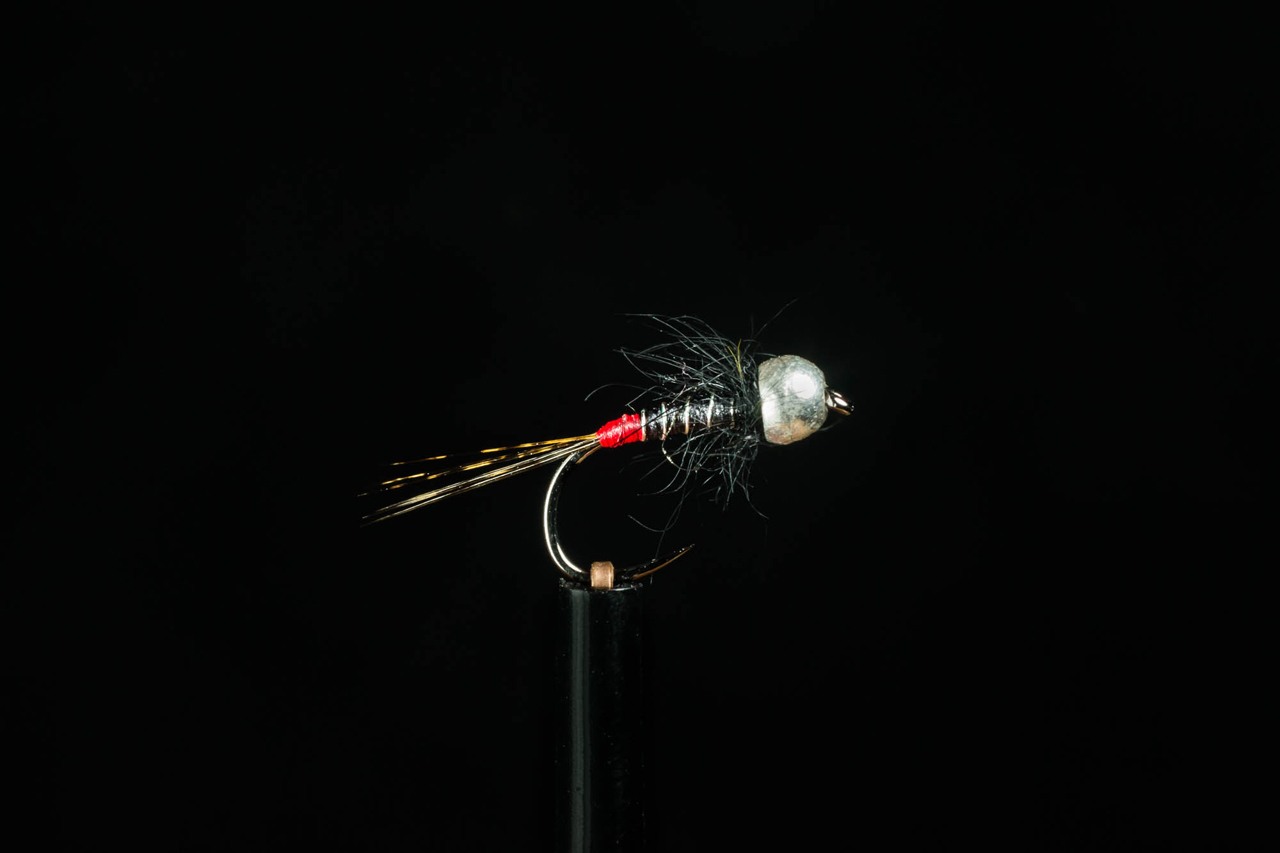
There’s a nearly endless menu of variations on this theme. However, by looking back at the two previous developmental steps, you can make much more informed and intelligent choices about your own French nymph pattern design and selection.
French Nymphing Legend: Pascal Cognard
Probably no account of French nymphing is complete without mentioning triple world champion Pascal Cognard. The stories I’ve heard from several sources about Pascal reveal someone with a truly exceptional understanding of fish behaviour.
He also possesses an uncanny knack to do exactly what is needed to unlock the most difficult (and feared) section or venue draws in competition.
Because of his all-round understanding of fish, he is equally impressive when it comes to stillwater fly fishing. In one competition that my brother was fishing in (and the going was incredibly tough), Pascal did the complete opposite to what every other angler was doing – and pulled out a winning score.
Most of the fish that competitors were able to catch came at extreme range. I’ll analyse in another article why, and how, Pascal had the confidence to fish right in the edge to take his fish.
Together with fellow French legend Jérôme Brosutti, Pascal has designed my personal favourite, high-end French nymphing rod (Marryat Tactical Pro 10' 6" #3 Nymph Special). Originally made by combining different sections of rods from a range of different disciplines together (and going through a version where the ring-spacing could be altered at will); by partnering with Marryat these rods are now widely available.
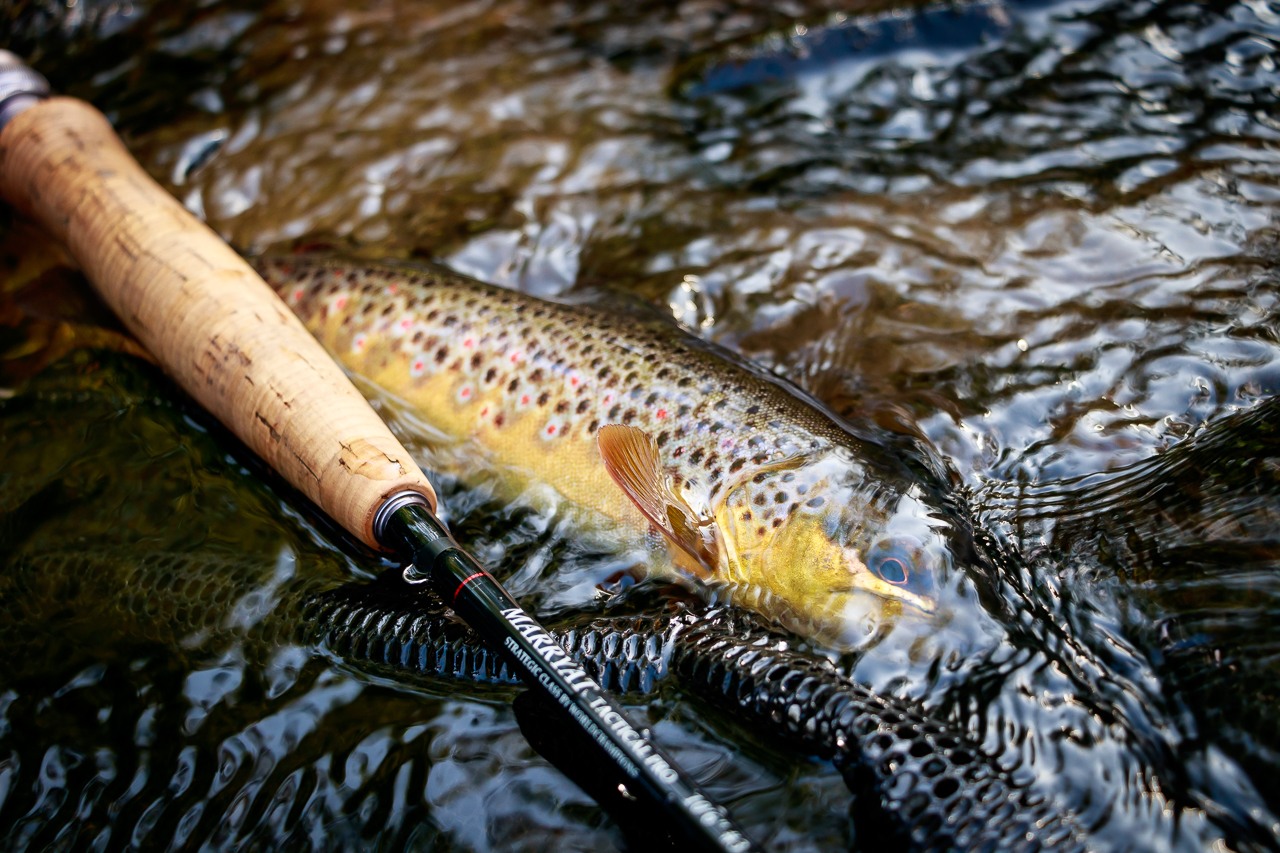
French Nymphing Roundup: First and Following Steps
From this roundup, it's easy to see how this works:
Our premium content allows us to create the free content (which lets you decide whether we know whether we’re worth listening to without you handing over money first).
The further up the levels of premium content you go, the bigger the benefits to your angling (and the more effort and value we can put into to those resources). At the same time, if you just want to dip your toe into the free content to find what we can most help you with, then you're very welcome.
To be notified of the ongoing releases of our best material – and benefit from the free email lessons in the meantime – Sign up to our Free “Distance-learning" Nymphing & Fly Fishing tutorials and special offers newsletter by entering your best email address here:
From this article you can:
From my Free Email Lessons You’ll be able to:
From Our Upcoming Premium Nymphing Content You’ll:
If you enjoyed this - smash the social share buttons on this page (it's good karma).
PLUS, let me know what other subjects you'd like to see covered in these articles - Just post up in the comments below.
Paul

I’d love to see information on fly fishing with wet flies.
I know you’ve already seen it but in case it helps anyone in the comments, there is a wet fly fishing article here: https://fishingdiscoveries.com/wet-fly-fishing/
Pablo muy bueno el contenido yo hace muy poco que empecé a pescar con moscas pero este artículo me pareció sumamente importante para seguir aprendiendo sobre este tipo de pesca líder francés. Hasta el momento siempre use pesca al hilo que anda bien pero creo que no es lo más conveniente para los ríos que tenemos aquí. Te mando un fuerte abrazo. Muchísimas gracias por toda la información.
Pablo gracias por tus amables comentarios y me alegra que el contenido te haya resultado util
Paul/Pablo
Hi Paul. Great content! I’m really intrested in learning more about dry flying fishing with a french leader. I often use a mono leader with a .o17″ butt section. Do french-styled leaders start with a butt section fairly thick as well, or more like .015″? Thanks much, and keep up the great work! Toney
how do i access premium content?
Hi Tim – apologies for slow reply; the product page for the French Nymphing (including all time-limited bonus content) is here: https://doublebadgers.kartra.com/page/French-Nymphing101
Paul,
Thanks for putting out the great content. I’ve watched and read the French Nymphing videos and supporting text many times and have enjoyed it. It’s true what you always say about paying a small fee for a lifetime of benefit. I’ve been using variations of the French leader for a few seasons now and still got a little something out of the material. Thanks again. I am just curious when we will learn that legendary John Pearson technique for making French leaders.
Thank you so much Daniel, I’ve been brewing an idea on the subject of leaders and, in fact, nymphing as a whole for a month or two now. Your question means it seems as good a time as any to float those ideas (and I’ll be asking email subscribers what they think as soon as I can). I recently sat down and pulled out my collection of written notes (some on notepad pages scribbled in northern Bohemia and torn out/filed in 2006, plus lots of digital files). I reckon I could pull those together into a near as damnit definitive guidebook to the modern nymphing galaxy- at least as I’ve experienced it with the help of many international anglers. It would seem to make sense to create supporting video material to go alongside that (to build on the 101 content within just a single branch of nymphing). As part of both written and video publications, I’d want to include detailed explanations of the processes, recipes and also rationale behind French leader design and construction.
So the short answer is actually a question I’ll be asking lots of people soon – “Do you think there is an audience eager to know those things?” That will help us decide whether we go ahead and throw everything at creating the book and video content.
Paul
This all sounds great, Paul. I’m very excited for the next chapter. Thanks again for all of the materials you have been putting out. And I think a book would be absolutely perfect. I love the print materials you have put out in the past and always look forward to the next one.
You’re very welcome Daniel and thanks for supporting our publications – I really appreciate it and I know John does too.
Paul
This is another great step in your informational driven content. I love the detail and the explanations. Does this replace your In Focus series? What ever, this is great
Hi Steve, it isn’t a replacement – it is a complement to the TiF stuff. Ultimately, what the Fishing Discoveries project will be about is turning people on to styles of fishing they hadn’t tried before. Once we gain a degree of trust (i.e. enough folks have tried some of our suggestions over time – and liked them), then it will be a route to switching thinking anglers on to legit, Japanese tenkara tactics.
But that is a super long game 🙂
Paul
Great article Paul. I have some water near me that falls into the category of water you mention in the article. (see video link). The fish aren’t super spooky, and they all range in the 6-12 inch range. Generally, in the summertime, you can go out with a dry fly and catch 30 fish in an afternoon. I was thinking this could be a great place to practice french nymphing. Anything to keep in mind when trying to practice this?
This video is of the river I’m thinking of:
https://www.youtube.com/watch?v=MrAyIsoXi_0
Excellent question Mark,
First up I would always say that clear water is a brilliant “laboratory” to learn things. You have the chance to observe the fish responding to your flies – AND the behaviour of your flies as the drift sub-surface.
Both of these things are really useful – for instance you can translate what you do with your rod-tip and leader to the effect it has on your sunk fly/flies. When you come to fish in more coloured water, you’ll still be able to visualise and translate what you do with your hands to how your flies are affected.
Secondly, you’ll also be able to calibrate what happens to your indicator braid/mono when a fish takes your fly – by being able to see both the fish and your indicator! Even with trout – though especially with European grayling – it can be amazing how many fish take your fly into their mouths without you easily noticing it on the indicator!
Also, with the fish seeming to be very happy to feed on the surface – you can experiment with throwing a single dry fly on a French Leader. This will improve your general casting with French Leaders and help you present lighter nymphs with more accuracy. You can also fish little/light nymphs and fish them in the upper layers of the water column to fish feeding at/near the surface.
On this last tactic – the water clarity will, again, provide useful intel because you can see how big of a nymph (and its associated splashdown) the fish will tolerate before spooking off. Going to my favourite topic of signal:noise ratio – the size of the splash that is tolerated will tend to be larger the deeper and more turbulent the water gets. Having the “right” sized splash will actually help attract fish to your nymph – as long as there aren’t “competing” splashes from your fly line or leader/indicator line landing on the water in close proximity.
That can even be true in shallow/flat calm – when dropping a tiny fly (ooh, let’s say a size 22 Philippe Beranger nymph?? hehe) gently onto the surface…
Good luck with your experiments – enjoy them and please report back with your experiences.
Paul
Thank you for the very detailed reply Paul and for the great article. Look forward to the premium content too!
No worries Mark – we’ve got your back bro 🙂
Paul
This sounds fantastic to me, I am a newby to all of this and looking forward to learning.
Welcome aboard Martin – I hope that we can help keep your learning curve as straight and steep as possible 🙂
Paul